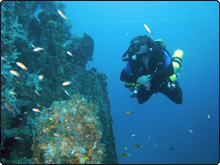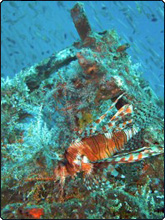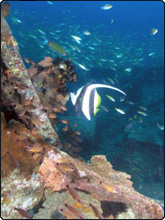At Dive The World we usually recommend only the very best dive sites and when it comes to diving in Sabah that means Sipadan, Mabul, Kapalai, Lankayan and Layang Layang.
However, by popular demand, we’ve decided to include the wreck diving enthusiasts among you, as well as people staying in Kota Kinabalu (KK) who want to venture further afield than the nearby Tunku Abdul Rahman Marine Park (TARP).

Usukan Bay Wrecks
About 2 hours by boat from KK, at a depth of between 25 – 40m, lie 3 World War II wrecks. Still in good condition, the wrecks are within close proximity to each other and make for a thrilling wreck diving excursion.
The Rice Bowl Wreck, Upside-down Wreck and Usukan Bay Wreck where names given to the sunken ships in lieu of accurate records confirming the real names of the Japanese vessels. The Usukan wrecks, some of the most interesting in Sabah, are full of life and since so few divers ever visit them you will often be the only people on site.
The bottom time here is not huge so if you are nitrox qualified you will feel the benefit and have more time to explore these excellent wreck diving sites. Let’s see what wreck treasures Dive The World can offer you at the bottom of the Sabah seas.
Rice Bowl Wreck
 The Rice Bowl Wreck was named for some of the first artefacts discovered on this wreck, which was, you guessed it, rice bowls. It was one of several Japanese ships reportedly sunk by the submarines USS Darter and USS Dace on 14 October 1944.
The Rice Bowl Wreck was named for some of the first artefacts discovered on this wreck, which was, you guessed it, rice bowls. It was one of several Japanese ships reportedly sunk by the submarines USS Darter and USS Dace on 14 October 1944.
The wreck settled on the ocean floor in a relatively upright position and is, for most part, intact. At 37m deep the wreck’s propeller and rudder are in place in an otherwise confusing stern. As you move towards a slightly twisted and partially collapsed bow area, a steam engine is visible.
Before the bow section, peering in through the portholes will reveal the artefacts that gave this wreck its name and entry into the room is possible through a break in the hull or through the hatch near the peak. The rice bowls are severely damaged and so overgrown with mostly hard corals, that it is now irrevocably part of nature.
Schools of batfish are at the ready to greet you and shoals of barracuda patrol the wreck. Scorpion fish are hidden amongst the multifaceted corals, so beware of where you put your hands when exploring the wreck up close.
Upside-down Wreck
Very near the Rice Bowl Wreck lies the Upside-down Wreck and no prizes for guessing in which position this sunken vessel came to rest. Having said that, the Upside-down Wreck is more slanted over the vertical to port than it is upside-down as such.
Possibly one of the larger of the wrecks, you will be amazed by the sheer size of it, as it seems to disappear into the blue. Some of the vessels are said to be up to 250m long and the Upside-down Wreck certainly comes close.
You will discover the shallowest part of the wreck around 25m with the deepest end slanting down to a sandy bottom at approximately 42m. Midway along the hull there is a relatively long, but easy swimthrough with impressive ship innards in the form of heavy machinery suspended above you.
At a depth which can’t sustain much human traffic for long, the Upside-down Wreck is a haven for pristine marine life. Schools of bigeye jacks and rainbow runners virtually obscure the view of the wreck, with lionfish and schooling glassfish skirting the ample coral growth inhabited by the likes of banded coral shrimps.
Having been part of the ocean for over 50 years, the Upside-down Wreck is covered with whip coral, daisy coral, an assortment of sponges and an Impressionist’s pallet of colourful soft coral. You are likely to spot the odd whitetip reef shark, corbias and giant groupers scouring the wreck for their next serving at the Upside-down Wreck coral buffet.
Usukan Bay Wreck
The Usukan Bay Wreck, one of the three Japanese World War II wrecks lying in the bay with the same name, met her final resting place at 40m.
Tipped over on the port side, you will find the basic structure of the hull intact, but noticing the war damage and general corrosion is unavoidable. The propeller and rudder is still where it should be though, and towards midship you will find a large steam engine and the adjacent boiler.
The wreck itself is encrusted with lavish black coral and soft coral coverage, with innumerable tunicates. Hard to avoid are the shoals of trevally and barracuda as well as untold numbers of basslets swarming all over the upper edges of the wreck.
Gaya Wreck
 A little closer to home off to the west of Gaya Island, the largest island in the TARP, lies another unidentified vessel. At a depth of between 35 – 50m the wreck is relatively unexplored, as it’s a technical dive only suited to divers with decompression diving experience.
A little closer to home off to the west of Gaya Island, the largest island in the TARP, lies another unidentified vessel. At a depth of between 35 – 50m the wreck is relatively unexplored, as it’s a technical dive only suited to divers with decompression diving experience.
This wreck is rumoured to be the Nittetsu Maru, a ship that closely fits the description of one of the Japanese vessels said to have been torpedoed that fateful October day. She settled in her final resting place in an upright position and has remained largely intact, save for a split hull at approximately mid ship and a collapsed wheelhouse.
This intriguing wreck is inhabited by varied and multitudinous marine creatures of the TARP on the inside and the outside. Several interesting penetration opportunities to explore the innards of the ship, brings a technical aspect to this wreck dive, but at the same time ensures it will be a memorable one.
You can discover these North Borneo wrecks of Sabah, and more, for yourself with Dive The World’s Wreck Diving Package.
6 Day / 5 Night Wrecking Diving Package
Price: US$ 980 per person sharing
Includes: 2 wreck dive days, (2 dives per day), a Pulau Tiga day (2 dives), a TARP day (3 dives), lunch, equipment rental, jetty fees, return boat transfers, 3 star accommodation, breakfast, hotel pick-ups;
Excludes: Non-air gas blends and twin-sets (available on request), park fees, flights, meals.
TDI and Rebreather training is also available as additional add-ons to the package. Ask us for more information.
For all the details or to book your wreck diving adventure in Kota Kinabalu, Sabah, call Dive The World on +66 (0)94 582 7973 / (0)83 505 7794, or
email: send us an email.